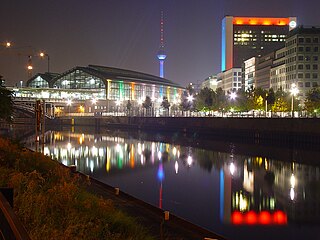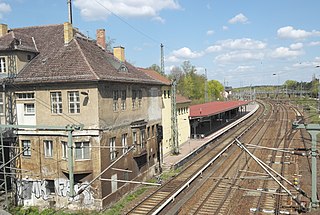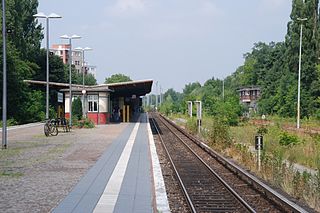History
Already before the electrified S-Bahn came about, there was a trial for electrified commuter trains running from Potsdamer Wannseebahnhof to Zehlendorf in 1902 and from Potsdamer Ringbahnhof to Lichterfelde Ost from 1903. Also in 1903, the AEG company ran an overhead wire test track from Niederschöneweide to Spindlersfeld. Electrification also came about as part of the solution to increase capacity along the Hamburg-Altonaer Stadt- und Vorortbahn .
World War I interrupted the electrification plans from 1914 to 1918, which, however, were revived just afterwards. In 1920 the Prussian state railways ordered six test trains, which were first pulled by steam locomotives until electrification commenced in 1923. One year later, on 8 August 1924, the first section from Stettiner Vorortbahnhof to Bernau was inaugurated; the two other northern railway lines to Oranienburg and Velten (Kremmen Railway) followed until 1927. To service all electrified connections, Deutsche Reichsbahn purchased 34 power cars and 51 trailers in total.
In everyday operation, however, the engines soon proved to be too weak and already in 1925 upgraded versions (the later DR Class ET 168 and ET 165) were ordered in large numbers.
After the war, the East German Deutsche Reichsbahn had planned to use modernized ET 169 trains on branch lines from Wannsee to Stahnsdorf and from Zehlendorf to Düppel, or as additional trains on the northern Ringbahn and on the Siemensbahn branch from Jungfernheide. But when the Berlin S-Bahn was divided due to the construction of the Berlin Wall in 1961, they were all again allocated to the Oranienburg, Bernau and Velten stretches of the line.
The trainsets were phased out from 1962 and most trains were withdrawn in 1969. Some components were re-used for the rolling stock of the East Berlin U-Bahn line E.

The Berlin S-Bahn is a rapid transit railway system in and around Berlin, the capital city of Germany. It has been in operation under this name since December 1930, having been previously called the special tariff area Berliner Stadt-, Ring- und Vorortbahnen. It complements the Berlin U-Bahn and is the link to many outer-Berlin areas, such as Berlin Brandenburg Airport. As such, the Berlin S-Bahn blends elements of a commuter rail service and a rapid transit system.

The S1 is a line on the Berlin S-Bahn. It operates over:

The Potsdamer Bahnhof is a former railway terminus in Berlin, Germany. It was the first railway station in Berlin, opening in 1838. It was located at Potsdamer Platz, about 1 km south of the Brandenburg Gate, and kick-started the transformation of Potsdamer Platz from an area of quiet villas near the south-east corner of the Tiergarten park into the bustling focal point that it eventually became. For more than a century it was the terminus for long-distance and suburban trains. Also located at this spot were underground stations on the Berlin U-Bahn and S-Bahn, and today's new underground Regionalbahnhof, known as Bahnhof Potsdamer Platz, while the short-lived M-Bahn crossed the site of the former terminus.

The Deutsche Reichsbahn or DR(German Reich Railways) was the operating name of state owned railways in the German Democratic Republic, and after German reunification until 1 January 1994.

The Ringbahn is a 37.5 km (23.3 mi) long circle route around Berlin's inner city area, on the Berlin S-Bahn network. Its course is made up of a pair of tracks used by S-Bahn trains and another parallel pair of tracks used by various regional, long distance and freight trains. The S-Bahn lines S41 and S42 provide a closed-loop continuous service without termini. Lines S45, S46 and S47 use a section of the southern and western ring, while lines S8 and S85 use sections of the eastern ring. The combined number of passengers is about 400,000 passengers a day. Due to its distinctive shape, the line is often referred to as the Hundekopf.

Oranienburg is a railway station located in Oranienburg, Germany. The station was opened in 1877 is located on the Berlin Northern Railway and the now closed Nauen–Oranienburg railway and Oranienburg–Velten railway. The train services are operated by Deutsche Bahn and Niederbarnimer Eisenbahn.

Birkenwerder is a railway station in the town of Birkenwerder, Brandenburg, Germany. The station lies of the Berlin Northern Railway and the train services are operated by Deutsche Bahn including Berlin S-Bahn services.

Berlin-Schönholz railway station is a railway station in Berlin, Germany. It is located on the Berlin Northern Railway line in the district of Reinickendorf, though it is named after the adjacent Schönholz quarter of the neighbouring Pankow district. From here, the Kremmen Railway branch line leads to Hennigsdorf and Kremmen. The station is served by S-Bahn trains and local bus lines, and is protected as a listed monument.

Berlin Nordbahnhof is a railway station in the Mitte district of Berlin, Germany. It is served by the Berlin S-Bahn and local bus and tram lines.

Berlin-Lichterfelde Ost station is on the Anhalt Suburban Line in Lichterfelde in the Berlin borough of Steglitz-Zehlendorf. It is served by S-Bahn line S25, S-Bahn line S26, and Regional-Express lines 3, 4 and 5.

Hennigsdorf is a railway station in the Oberhavel district of Brandenburg, located in the town of Hennigsdorf. It is the northern terminus of the S-Bahn line S25 as well as a station for regional passenger trains and freight services.

The North–South S-Bahn Tunnel is the central section of the North–South transversal Berlin S-Bahn connection crossing the city centre. It is not to be confused with the Tunnel Nord-Süd-Fernbahn, the central tunnel part of the North–South main line used by intercity and regional trains. The S-Bahn North–South line encompasses the route from Bornholmer Straße and Gesundbrunnen via Friedrichstraße and Anhalter Bahnhof to Papestraße and Schöneberg.

The first section of the Berlin–Magdeburg Railway was opened in 1838 as the Berlin-Potsdam Railway and was the first railway line in Prussia. In 1846 it was extended to Magdeburg.

The Berlin–Szczecin railway, also known in German as the Stettiner Bahn is a mainline railway built by the Berlin-Stettin Railway Company between the German capital of Berlin and the now Polish city of Szczecin, then part of Prussia and known as Stettin. It is one of the oldest lines in Germany, built in 1842 and 1843 and was the company's trunk line. The line was duplicated between Berlin and Angermünde in 1863 and between Angermünde and Szczecin in 1873.

The Wannsee Railway is a suburban railway in Berlin running from Potsdamer Platz via the Ring line station of Schöneberg to Wannsee station on Großer Wannsee, a lake after which it is named. Today it is a section of the Berlin S-Bahn line S1.

The Kremmen Railway is a line in northern Berlin and Brandenburg, Germany. It branches off the Prussian Northern Railway in the Berlin district of Reinickendorf, north of Schönholz station and then passes through Tegel, Hennigsdorf and Velten to Kremmen. There it connects with the Kremmen–Meyenburg line opened in 1898 to Neuruppin.

S15 is a planned second north-south route for the Berlin S-Bahn, which will connect Berlin Hauptbahnhof to the Berlin Ringbahn to both north and south. The first section is under construction and is expected to go into operation in 2024.

The Berlin S-Bahn began on 8 August 1924 with the first section from Stettiner Vorortbahnhof to Bernau using steam locomotives. On 13 August 1961 it was broken up when the Berlin Wall was built, resulting in two sections: the eastern part and the western part. The western part experienced a massive strike which resulted in closure of several stations, after declining use. Attempts were made to reopen at various times but in the end, only three lines were finally opened after the strike. Since 9 November 1989, when the Berlin Wall was opened, the Berlin S-Bahn began to expand rapidly with their budgetary costs.

The DR Class ET 169 was the first class of electric multiple units for use on the Berlin S-Bahn commuter lines. 17 five car units were ordered by the Deutsche Reichsbahn in 1925, each comprising two motor cars with bogies and three short four-wheelers. They were intended for service on the northern lines from Stettiner Station to the rural towns Bernau, Oranienburg and Velten.

Siemensbahn is an abandoned 4.5 km rapid transit line of the Berlin S-Bahn in Berlin. It was opened in 1929 as a modern, grade separated, third rail electrified, double track, heavy rail branch line serving three new train stations, and closed in 1980.




















